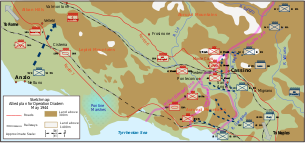- Operation Diadem
-
Invasion of Sicily – Invasion of Italy – Armistice with Italy – Four days of Naples – Vatican Bombing – Volturno Line – Barbara Line – Bari Raid – Bernhardt Line – Moro – Ortona – Monte Cassino – Anzio – Trasimene Line – Ancona – Gothic Line – Battle of Garfagnana – Spring offensive 1945 – Argenta Gap
Operation Diadem, also referred to as the Fourth Battle of Monte Cassino was an offensive operation undertaken by the Allies (U.S. Fifth and British Eighth Armies) in May 1944, as part of the Italian Campaign. It was launched at 2300 Hours on 11 May 1944 to break the German defenses on the western half of the Winter Line and open up the Liri Valley, the main route to Rome. General Harold Alexander, the overall Allied army commander in the Italian theater, planned Diadem and the supporting air attacks of Operation Strangle to roughly coordinate with the invasion of northern France on 6 June 1944 in order to tie down the maximum number of German divisions in Italy, thus preventing them being employed against the invasion forces on France's coast.
The key movements in the battle were the successful opposed crossing of the River Rapido at the mouth of the Liri valley by British XIII Corps, drawing in the German reserves, and the outflanking breakthrough on their left achieved by Free French Forces, including Moroccan Goumiers on May 14. This caused the German Gustav Line to collapse and they fell back on the Hitler Line some 10 miles to their rear. The fighting had drawn all of the German reserves into the Liri valley reducing pressure on the Anzio beachhead, some 60 miles northwest and facilitating Alexander's planned breakout there, known as Operation Buffalo, which took place on May 23, simultaneously with the main assault on the Hitler Line.
The Hitler Line was breached by 1st Canadian Infantry Division's 4th Princess Louise Dragoon Guards at Pontecorvo on May 23, 1944, supported on their right by the Polish II Corps. Forced to retire northwestward, the German Tenth Army were on the point of having their line of retreat cut by U.S. VI Corps breaking out from Anzio, when General Mark Clark, commander U.S. 5th Army, inexplicably ordered them to alter their line of advance by ninety degrees to the left and advance on Rome. There is much speculation that he gave the order for fear that the British 8th Army would advance up Route 6 and capture Rome ahead of his U.S. 5th Army. The German 10th Army thus avoided being surrounded and fought a series of delaying actions before retiring to the Trasimene Line and then to the Gothic Line, identified on German maps as the "Green" Line, north of the Arno River. Though construction of the latter defences had begun in autumn of 1943, British 8th Army's subsequent pursuit of the reeling German forces (some 240 miles in six weeks) compelled the Wehrmacht's engineers to expedite its completion. Nearly 3,000 machine guns and hundreds of reinforced dugouts were emplaced as were concrete pillboxes mounting fully operable turrets from Mark IV tanks.
See also
World War II Participants Timeline Aspects GeneralWar crimes- German and Wehrmacht war crimes
- The Holocaust
- Italian war crimes
- Japanese war crimes
- Allied war crimes
- Soviet war crimes
- United States war crimes
- German military brothels
- Camp brothels
- Rape during the occupation of Japan
- Comfort women
- Rape of Nanking
- Rape during the occupation of Germany
- Nazi crimes against Soviet POWs
- Italian prisoners of war in the Soviet Union
- Japanese prisoners of war in the Soviet Union
- Japanese prisoners of war in World War II
- German prisoners of war in the Soviet Union
- Finnish prisoners of war in the Soviet Union
- Polish prisoners of war in the Soviet Union
- Romanian prisoners of war in the Soviet Union
- German prisoners of war in the United States
Categories:- World War II operations and battles of the Italian Campaign
- Conflicts in 1944
- Battles and operations of World War II involving France
- 1944 in Italy
- Italian Campaign
Wikimedia Foundation. 2010.

